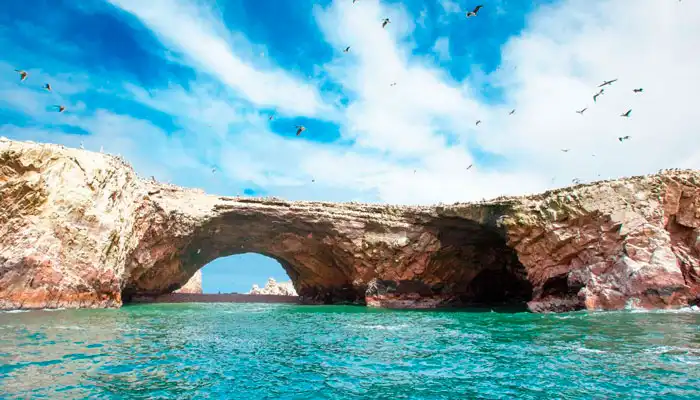
It’s not enough just to gaze at the Pacific Ocean and take pictures of its splendid sunsets. Swimming in its waters or lounging peacefully on its shores simply won’t do. Don’t settle for that on the Peruvian coast, which awaits you with the chance to sail to an archipelago “taken” by marine wildlife.
A country with views of the sea, Peru is a destination for sandy beaches and good waves. Surfing or diving lessons, journeys in search of humpback whales, and even the opportunity to sail in the totora reed boats—an artisanal vessel of pre-Hispanic origin—are options you should consider for your next holiday.
But if you want to discover the main maritime destination of the Peruvian Pacific, you need to head to the district of Paracas (in the province of Pisco, Ica region) to set sail on a tourist skiff towards Ballestas, a group of small islands that will captivate you with their rugged geography and surprising biodiversity.
This spectacular journey takes you through a natural space that enthusiasts affectionately call “the Galápagos of Peru.” Whether that’s reality or exaggeration, the experience you’ll have in Ballestas, spotting marine mammals and guano birds, is unique, intense, and unforgettable.
So, what are you waiting for? Set off from the artisanal dock of Chaco towards the Paracas Candelabra, an enigmatic geoglyph, the colonies of sea lions frolicking among the rocks, and the guano islands where birds seem to dance in the sky in a unique welcome ritual.
Before you travel to Paracas and the Ballestas Islands, hop aboard this “cruise” of facts and information that will be very useful for your ocean adventure. All aboard!
Contents
Ballestas: a reserve of life
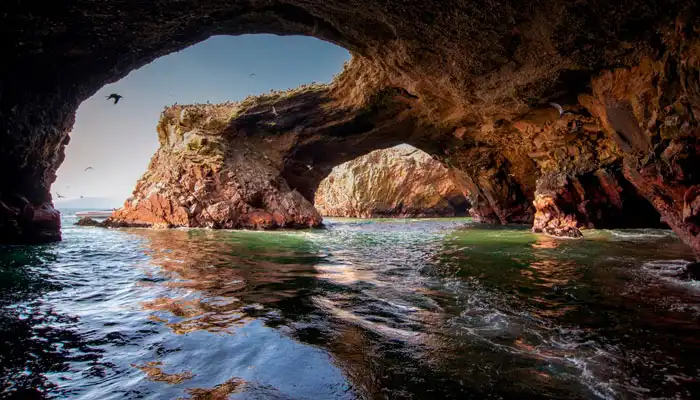
In the mornings, when the sea, the wind, and the fog allow it, the Chaco dock comes alive with excitement and movement. Groups of travellers gather around the guides who direct them to the boats that will take them to meet islands that, due to their ecological richness, are part of a national reserve.
Established to conserve the ecosystems of the cold sea of the Humboldt Current, the National Reserve System of Islands, Islets, and Guano Points encompasses coastal areas located between the regions of Piura and Moquegua. These areas showcase representative samples of the biological diversity of the Peruvian sea.
Ballestas is part of this select group. Its protection is a priority for the wellbeing and balance of the coastal marine ecosystem of Paracas Bay; because beyond the enjoyment of tourist excursions, it’s essential to commit to and promote the need to preserve our oceans.
Only in this way can we ensure the conservation of islands whose geological formation dates back millions of years. Volcanic in origin, their surface is dominated by rock formations, shaped by the relentless forces of wind and water that have eroded them over time.
The crew is complete. The skiff pulls away from the dock. The adventure begins, and you’ll feel the breeze on your face as your anticipation grows for what you are about to see: the flight of seagulls, the appearance of a dolphin, the mysterious image of a Candelabra etched into the hillside.
This is just the beginning. Think and imagine what you will see next.
Islands with a History
In Peru, there’s always a historical event that adds extra interest to its tourist areas. This is the case in Ballestas, where archaeological remains dating back over 6,000 years have been found. It is also known that the Paracas and Nazca cultures, two pre-Incan societies, exploited marine resources and bird guano.
This utilisation continued during the Viceroyalty. It is highly likely that during this period, the islands served as a point of reference and navigation for seafarers. However, no permanent colonies were established in this extraordinary sector of the Peruvian Pacific.
The situation changed during the Republican era. In the mid-19th century, the so-called “Guano Era” took place, a historical period when the powerful natural fertiliser produced from the droppings of various seabirds became the driving force of the national economy.
Guano is produced by birds such as the guanay, the Peruvian booby, the Humboldt penguin, and the Peruvian pelican, among others, that flutter around the islands off the Peruvian coast, which is the main producer of this fertiliser rich in nitrogen, phosphorus, and potassium.
While it no longer holds the economic significance it once did, guano collection still takes place in Ballestas. The Pisqueñas islands opened up to tourism in the 1950s, and over the years, the destination has solidified its status, becoming one of the main attractions in the south. You can’t miss it!
Ballestas in their Natural State
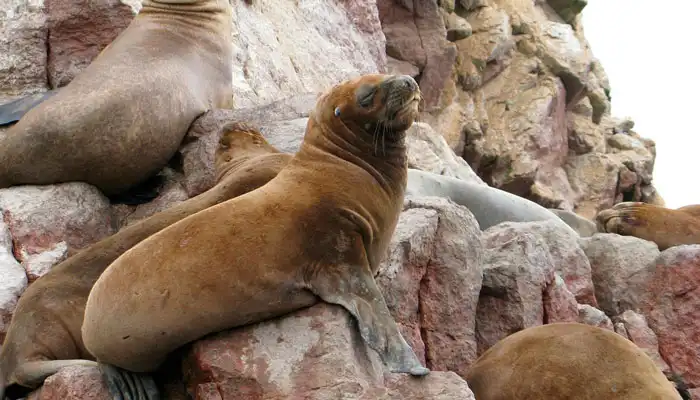
Protecting and preserving the islands for the future is the mandate. From this perspective, Peruvian authorities, tour operators, and the travellers themselves have the responsibility to care for the fragile coastal marine ecosystem and the stunning biodiversity of Ballestas.
In the pursuit of sustainable utilisation, boats are not allowed to approach the shores of the islands. During wildlife observation, engines must be turned off; this is crucial in the area known as the Maternity, named for being the breeding ground of the sea lions.
Similarly, landing on the islands and swimming in the waters of Ballestas is prohibited. Human presence disrupts marine species and threatens their habitats. Remember, you are in a protected natural area, not a zoo or water park.
With these and other measures, the fauna (mammals, molluscs, fish, crustaceans, reptiles, and birds) and flora, which, although not very abundant, is perfectly adapted to the extreme dryness and intense sun, are preserved.
Here is a brief list of the flora, birds, and mammals of Ballestas:
Flora
- Tique (Cryptantha maritima)
- Saline grass (Distichlis spicata)
- Beach purslane (Sesuvium portulacastrum)
- Lichen species
- Seaweed
Fauna
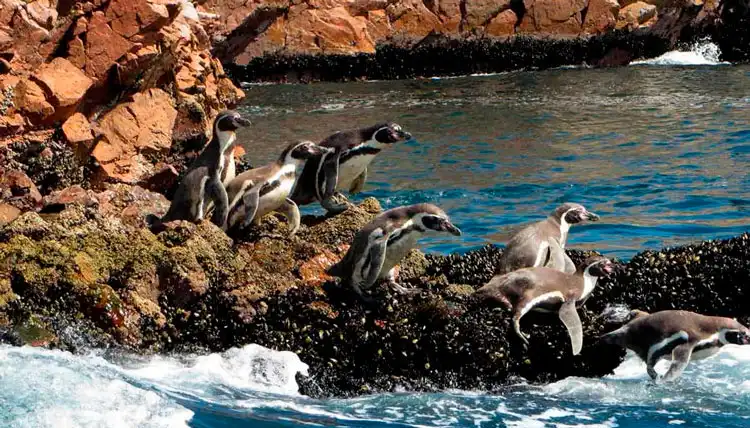
Birds:
- Guanay (Phalacrocorax bouganvillii)
- Peruvian booby (Sula variegata)
- Peruvian pelican (Pelecanus thagus)
- Chuita (Phalacrocorax gaimardi)
- Inca tern (Larosterna inca)
- Occasionally, Andean condors (Vultur gryphus) can be spotted.
Mamíferos:
- Southern sea lion (Arctocephalus griseus)
- South American sea lion (Arctocephalus australis)
- Bottlenose dolphin (Tursiops truncatus)
- Occasionally, humpback whales (Megaptera novaeangliae) are seen.
Diversión en mar y tierra
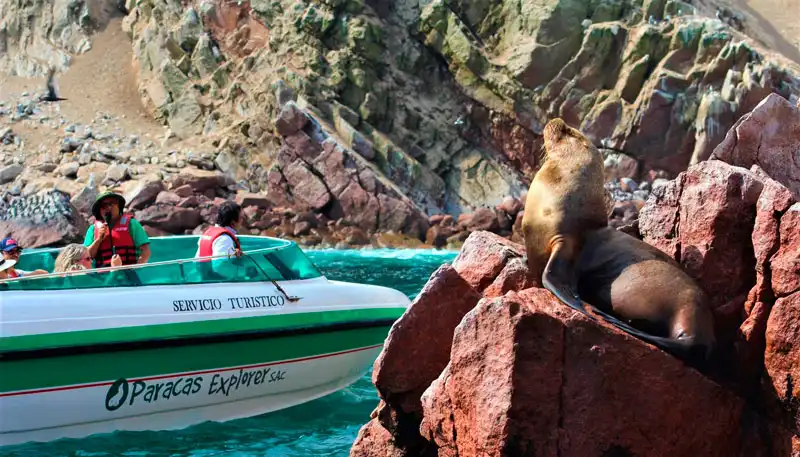
Sailing, observing, and taking photographs or videos—these are the activities you’ll enjoy during your tour. So, stay alert to capture the best shots of the Paracas Candelabra, the guano birds, and the colonies of South American and southern sea lions.
For approximately two hours, the sea and the islands will be your world, your space, your place on the planet. You’ll feel the strength of the wind, breathe in the pure air, and, to the rhythm of the waves, discover a privileged space where humans are merely observers, intruders, strangers.
Upon returning to the dock, a range of tourist possibilities opens up, from an excellent and authentically Peruvian seafood lunch at the restaurants along the Chaco promenade (someone mentioned ceviche and pisco sour) to a diving and snorkelling experience in the waters of Paracas, among other nautical activities.
In the afternoon, it’s almost a must to visit the Paracas National Reserve. Accessible by land (you can also walk or cycle), you’ll spot flamingos, explore the exhibits at the Julio C. Tello Site Museum, and discover hidden beaches that will amaze you.
How to Get to the Ballestas Islands?
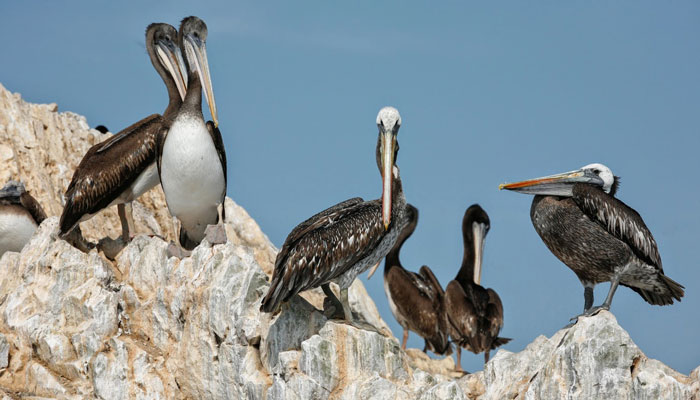
Due to its strategic location and proximity to the Pan-American Highway, reaching the district of Paracas is not a daunting task, especially if you are in Arequipa, Cusco, or Puno, to name just a few important cities in southern Peru’s tourist circuit.
In all these cases, you will need to take a bus to Lima, the capital of Peru. Once you reach the coast and pass through the cities of Nasca, Palpa, and Ica, you should disembark at the turn-off for Paracas (kilometre 245). From there, you can continue by taxi or shared minibus to your final destination.
From Lima, the journey takes about three hours. The company Cruz del Sur offers direct services to Paracas (departures from 4:00 a.m., cost: 60 soles). If you choose other bus companies, you will need to get off near Pisco or at the Paracas turn-off. If you want to avoid the hassle, it’s a good idea to hire a local operator or rent a vehicle.
At the Chaco dock, you’ll find the skiffs to Ballestas. Departures are only in the morning and may be cancelled due to weather conditions. The cost of the tour ranges from 40 to 60 soles, which includes the guided tour, but does not cover the dock fee (5 soles) or the access fee to the natural area (11 soles).
Keep in mind that landing on the islands is prohibited, and the tourist skiffs must maintain a safe distance from the shores to avoid disturbing the wildlife. The tour consists of sailing and observing nature from the sea—an exciting experience that lasts approximately two hours.
Travel Recommendations
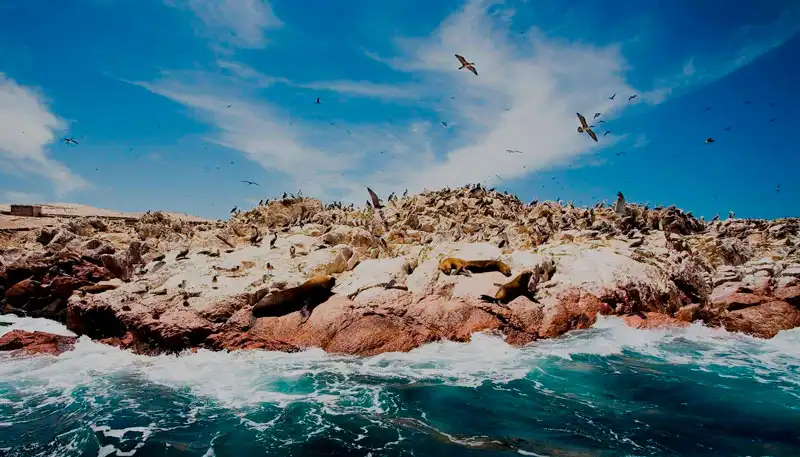
- Book in advance, especially during peak season (October to March). This is the best time to visit Ballestas, as the skies are clear and the temperatures are more pleasant.
- As the saying goes, it’s better to be safe than sorry, so always bring a windbreaker or waterproof jacket. A warm layer is also a good idea, as the wind can catch overly confident travellers off guard.
- Make sure to use sunscreen, sunglasses, and a hat (or cap) for protection.
- The tour is perfect for capturing stunning photographs. If you have a zoom lens, now’s the time to make the most of it. If you plan to shoot video, a stabiliser or gimbal will be essential for smooth shots.
- Please be respectful of the ecosystem. Avoid excessive noise and sudden movements, as these can disturb the sea lions and guano birds. Also, do not attempt to touch any animals.
- It is prohibited to throw any solid or liquid waste into the sea at Ballestas.
- Always wear your life jacket and follow the guide’s and tour operators’ instructions. This way, you can fully enjoy your maritime experience.
- Don’t forget to bring water to stay hydrated during your journey.






